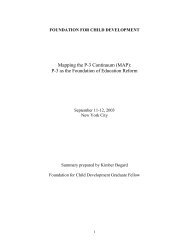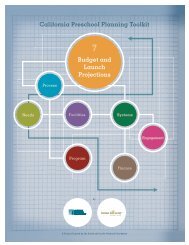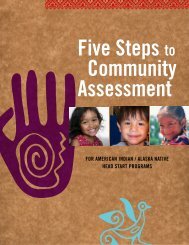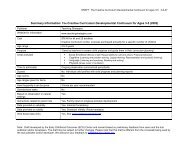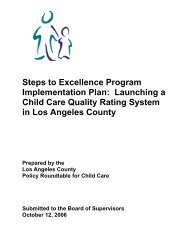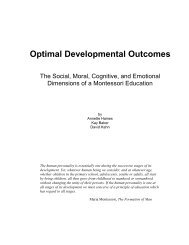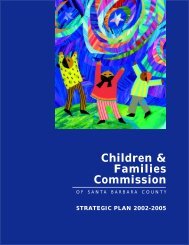Download this file - Plan4Preschool
Download this file - Plan4Preschool
Download this file - Plan4Preschool
You also want an ePaper? Increase the reach of your titles
YUMPU automatically turns print PDFs into web optimized ePapers that Google loves.
For more information regarding the K–3 Class Size Reduction Program, contact<br />
Lynn Piccoli, Consultant, School Facilities Planning Division, at (916) 323-3926 or by<br />
e-mail at lpiccoli@cde.ca.gov. Additional information is also available on the Class Size<br />
Reduction Web site at http://www.cde.ca.gov/ls/cs.<br />
Class Size Reduction, Grade Nine<br />
This program provides incentive funding for school districts to reduce grade nine class<br />
size to an average of 20 students to one teacher in English classes and in one<br />
additional subject (mathematics, science, or social studies). Individual schools within the<br />
district may select the second core subject area.<br />
The Morgan-Hart high school class size reduction (CSR) program was established in<br />
1989; it was amended by Senate Bill 12 (Chapter 334) of 1998 to focus on grade nine.<br />
Funding is determined annually in the state Budget Act, which provides $204 per<br />
student for 2006-07. Districts must reapply each year.<br />
Participating courses must count toward completion of high school graduation<br />
requirements as described in California Education Code Section 51225.3(a). Each<br />
participating school must certify that CSR classes have an average ratio of 20 students<br />
(or fewer) to one teacher. Special education pupils enrolled in special day classes on a<br />
full-time basis and pupils enrolled in necessary small schools are excluded from <strong>this</strong><br />
program. In addition, county boards of education and county superintendents of schools<br />
are not eligible to participate.<br />
For more information regarding the CSR program, please contact John Merris-Coots,<br />
Consultant, High School Initiatives/Career Education Office, at (916) 310-0461 or by<br />
e-mail at jmerris@cde.ca.gov. Additional information is also available on the High<br />
School CSR Web site at http://www.cde.ca.gov/ls/cs/mh.<br />
Class Size Penalties<br />
California Education Code (EC) sections 41376 and 41378 prescribe the maximum<br />
class sizes and penalties for districts with any classes that exceed the following limits:<br />
• Kindergarten—average class size not to exceed 31 students; no class larger than<br />
33 students<br />
• Grades one through three—average class size not to exceed 30 students; no class<br />
larger than 32 students<br />
• Grades four through eight—current fiscal year average number of pupils per<br />
teacher not to exceed the greater of the statewide average number of pupils per<br />
teacher in 1964 (29.9) or the district’s average number of pupils per teacher in 1964<br />
The intent of these laws is to encourage the reduction of class size and the ratio of<br />
pupils to teachers. In the past, school districts that incurred a class size penalty were<br />
able to submit waiver requests to the State Board of Education (SBE) and, if the SBE<br />
approved the waiver, the penalty was adjusted. EC Section 41344 (Chapter 78, Statutes<br />
124



